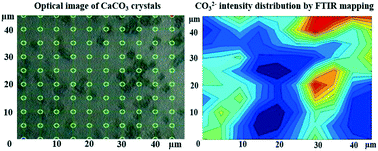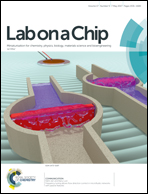Synchrotron FTIR mapping of mineralization in a microfluidic device†
Abstract
Fourier transform infrared micro-spectroscopy provides an effective means of performing rapid, non-destructive, and label-free analysis of specimens according to their vibrational modes. However, as water absorbs very strongly in the infrared region, analysis of aqueous solutions in transmission mode can suffer from problems with signal saturation. We here describe the fabrication of a novel microfluidic device that overcomes this problem. Devices with channel depths of just 3 μm were constructed from calcium fluoride using photolithography and hot embossing bonding, where calcium fluoride was selected due to its transparency in the IR region. The utility of this device was then demonstrated by employing it to follow the precipitation pathways of calcium sulfate and calcium carbonate using synchrotron FTIR micro-spectroscopy. Importantly, due to the high brightness provided by synchrotron radiation, and the fact that the reacting ions (HCO3−, CO32− and SO42−) and the different mineral polymorphs all have finger print spectra in the measured IR range, this method can be used to acquire time-resolved, hyperspectral maps of the mineral particles formed within the sample cell, and then study the interaction and evolution of particles. The data provide new insight into the formation pathway of a population of crystals in confined volumes, and demonstrate that this in situ, real-time detection system provides a powerful tool for studying crystallization processes.



 Please wait while we load your content...
Please wait while we load your content...